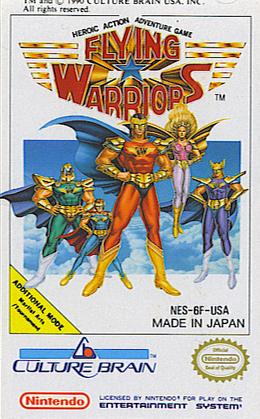Flying Warriors
| Flying Warriors | |
|---|---|
 Front cover of Flying Warriors portrayed the characters as Western comic book superheroes, instead of the Saint Seiya-style gladiators. | |
| Developer(s) | Culture Brain |
| Publisher(s) | Culture Brain USA |
| Platform(s) | Nintendo Entertainment System |
| Release date(s) |
|
| Genre(s) | Action |
| Mode(s) | Single-player |
| Distribution | Cartridge |
Flying Warriors is a 1991 action/fighting video game developed by Culture Brain and published by Culture Brain USA exclusively for the NES in North America in February 1991. It is a mixture of two Family Computer video games in the Hiryū no Ken franchise: Hiryu no Ken II: Dragon no Tsubasa and Hiryu no Ken III: 5 Nin no Ryuu Senshi. It implements ideas and elements from both games, thus making it hard to tell which of the two is officially its Japanese version.
The first installment of the Hiryū no Ken series had already been released in North America as Flying Dragon: The Secret Scroll, with virtually no modification.
Gameplay
The game features combat in a variety of formats, such as kicking and using fireballs to repel monsters in scrolling stages, a system during one-on-one duels against Tusk Soldiers or a pair of martial arts tournaments where the player must attack a mark that appears on their opponent's body, or defend the area when it appears on them (this system is similar to Culture Brain's original Flying Dragon for the NES), and RPG-style command battles against monster bosses. When confronted by a Tusk Soldier or other otherworldly villain, Rick can change into a costumed superhero form or switch with one of his teammates. The player must switch to Flying Warrior form to use the characters' magic powers and defend themselves from the Tusk Soldiers' magic spells.
Plot
In an unexplored region of China wrapped in mystery, Ryuhi, a boy, was born and brought up in high mountain tops. There he received instruction from his wise teacher, Juan. Though he was young, he made himself a master of Kempo.
One day, his teacher Juan was attacked and robbed of the Secret Scrolls of Hiryu-no-Ken, of which he was the author. Ryuhi possessed the 6th volume of the Secret Scrolls, the Shingan-no Sho, or book of the mind's eye which Juan had managed to save. Ryuhi begins his journey to Shorinji in compliance with Juan's last request. Gengai, the bishop of Shorinji welcomed the little Ryuhi, regarded as one of the titans of Shourinji Kempo.
Six years later, they received a letter of challenge from the Tusk Soldiers, a mysterious organization of enemies of the Shorinji. Ryuhi is determined to take part in the upcoming "World Tournament of Contact Sports" as a representative of Shorinji. His desire is to prevent the Tusk Soldiers from becoming champions of Contact Sports at the tournament.
Ryuhi heard from Gengai that in truth it was the Tusk Soldiers who attacked his teacher and robbed him of the Secret Scrolls. As he leaves for the World Tournament, his thoughts are on his teacher Juan and keeping the fighting spirit burning.
Development
Regional differences
In the English game, Ryuhi was named Rick Stalker, and Fuzi Fu was named Dargon.
Reception and legacy
Some major characters later appeared in the North American versions of Hiryū no Ken Gaiden and Hiryū no Ken S: Golden Fighter, known as Fighting Simulator: 2-in-1 Flying Warriors and Ultimate Fighter. Rick Stalker and his mentor Gen also appeared as cameos in several titles in the Super Chinese series, also by Culture Brain. A manga adaption based on the game was translated and published in the early issues of GamePro magazine.
References
| ||||||||||||||